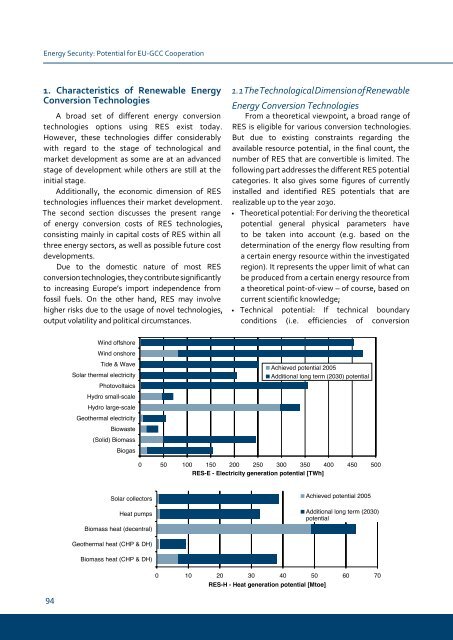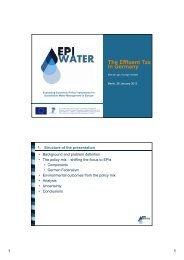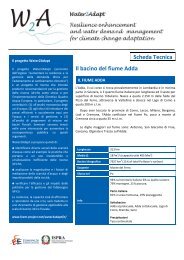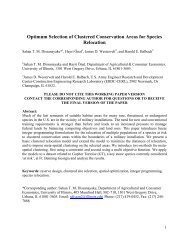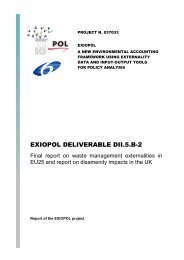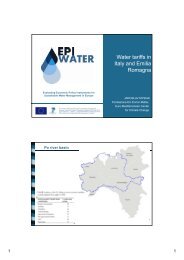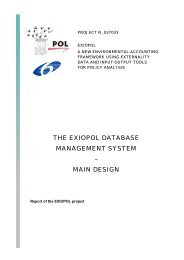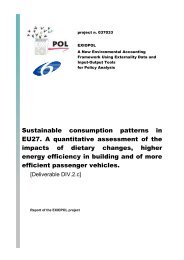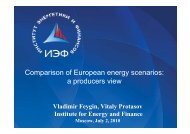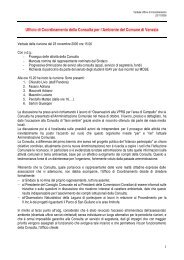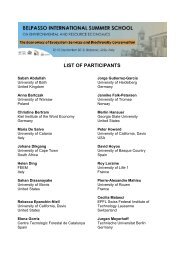Gulf and European Energy Supply Security - Feem-project.net
Gulf and European Energy Supply Security - Feem-project.net
Gulf and European Energy Supply Security - Feem-project.net
Create successful ePaper yourself
Turn your PDF publications into a flip-book with our unique Google optimized e-Paper software.
<strong>Energy</strong> <strong>Security</strong>: Potential for EU-GCC Cooperation<br />
1. Characteristics of Renewable energy<br />
Conversion technologies<br />
A broad set of different energy conversion<br />
technologies options using RES exist today.<br />
However, these technologies differ considerably<br />
with regard to the stage of technological <strong>and</strong><br />
market development as some are at an advanced<br />
stage of development while others are still at the<br />
initial stage.<br />
Additionally, the economic dimension of RES<br />
technologies influences their market development.<br />
The second section discusses the present range<br />
of energy conversion costs of RES technologies,<br />
consisting mainly in capital costs of RES within all<br />
three energy sectors, as well as possible future cost<br />
developments.<br />
Due to the domestic nature of most RES<br />
conversion technologies, they contribute significantly<br />
to increasing Europe’s import independence from<br />
fossil fuels. On the other h<strong>and</strong>, RES may involve<br />
higher risks due to the usage of novel technologies,<br />
output volatility <strong>and</strong> political circumstances.<br />
4<br />
Wind offshore<br />
Wind onshore<br />
Tide & Wave<br />
Solar thermal electricity<br />
Photovoltaics<br />
Hydro small-scale<br />
Hydro large-scale<br />
Geothermal electricity<br />
Biowaste<br />
(Solid) Biomass<br />
Biogas<br />
Solar collectors<br />
Heat pumps<br />
Biomass heat (decentral)<br />
Geothermal heat (CHP & DH)<br />
Biomass heat (CHP & DH)<br />
1.1 The Technological Dimension of Renewable<br />
<strong>Energy</strong> Conversion Technologies<br />
From a theoretical viewpoint, a broad range of<br />
RES is eligible for various conversion technologies.<br />
But due to existing constraints regarding the<br />
available resource potential, in the final count, the<br />
number of RES that are convertible is limited. The<br />
following part addresses the different RES potential<br />
categories. It also gives some figures of currently<br />
installed <strong>and</strong> identified RES potentials that are<br />
realizable up to the year 2030.<br />
• Theoretical potential: For deriving the theoretical<br />
potential general physical parameters have<br />
to be taken into account (e.g. based on the<br />
determination of the energy flow resulting from<br />
a certain energy resource within the investigated<br />
region). It represents the upper limit of what can<br />
be produced from a certain energy resource from<br />
a theoretical point-of-view – of course, based on<br />
current scientific knowledge;<br />
• Technical potential: If technical boundary<br />
conditions (i.e. efficiencies of conversion<br />
Achieved potential 2005<br />
Additional long term (2030) potential<br />
0 50 100 150 200 250 300 350 400 450 500<br />
RES-E - Electricity generation potential [TWh]<br />
0 10 20 30 40 50 60 70<br />
RES-H - Heat generation potential [Mtoe]<br />
Achieved potential 2005<br />
Additional long term (2030)<br />
potential


